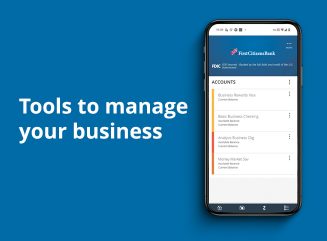
Digital banking for business
Seamlessly access all of your accounts from one place with First Citizens Digital Banking for business.
The world is full of potential hazards. It's only a matter of time before even the best-laid business plans run into some unforeseen setbacks. If you're able to anticipate these problems ahead of time, you can potentially minimize the damage—or even avoid it altogether. That's why part of your organization's strategy should include developing an effective risk management plan.

A risk management plan is a document that formally lays out your process for identifying, avoiding and dealing with risks. By thinking about this beforehand, you can take steps to avoid those problems and better prepare your employees to handle the issue.
You could put together a risk management plan at the start of a major project, as the team gets ready to launch. You could also design organization-wide risk management protocols for different areas, such as cybersecurity and compliance. The key is to start thinking about business risk management proactively and identifying what you'd do if the case arose, rather than scrambling only after something happens.
The general framework for a risk management plan is as follows:
What are you trying to accomplish, either with a specific project or for your organization? Think of where you'd like to end up if everything goes smoothly.
Next, brainstorm all the potential risks that could get in the way of your objectives. These could include operational, financial, cybersecurity and regulatory or liability risks. Examples of those, respectively, include when a supplier fails to deliver on time, you go over budget, you encounter ransomware, viruses or malware, or when an employee accidentally breaks government rules, leading to a fine.
Unpredictable swings could also work in your favor, such as vendor prices dropping suddenly or your team reaching goals more quickly. Anticipate these as well, so you know how to maximize the opportunity.
Your team should consider how likely each risk is, as well as the potential impact on your organization or project.
For low-consequence risks, you may decide just to accept them as they come. For example, you may absorb the occasional price increase for supplies that aren't a major part of your budget. For more damaging issues, lay out your process for avoiding them, either by setting up in-house procedures yourself or transferring the work and risk to someone else, such as by hiring a vendor who assumes liability. If you do run into a problem, consider how you'd mitigate the damage—for example, your process to contain a hack and data breach.
Going through this mental exercise is a good start, but your risk management plan will have more weight if you write it out as formal procedures. Highlight each risk and how you've decided to manage them. Then, identify the key parties responsible for supervising each aspect. They should know what events to watch out for and the planned responses to each one.
Then, move forward with any strategies for offsetting common areas of business risk, including setting up new cybersecurity procedures and signing up for insurance. This also requires employee training. Stress how these new efforts will protect your company and tie it to your long-term goals. That way, employees appreciate why the work is needed and it doesn't just feel like one more bureaucratic hoop.
Periodically, you should meet with the key stakeholders implementing your plan. This could be on a set schedule for ongoing policies, such as once a quarter or annually, as well as once you've hit major project milestones, especially when it changes the situation. An evaluation would be ideal, for example, after you've completed the development of a new product and are moving into the launch phase.
In these meetings, collect feedback on the current risk management plan, especially with whatever risks your team has encountered and the result. Then, use this data to improve your plan accordingly. It's important to get their feedback on how the situation evolved, whether they see new potential risks on the horizon and if some of the previous risks are less likely now.
Ultimately, risk management is an ongoing process because potential trouble is always looming. By keeping this framework in mind, your organization can stay on top of any problems before they arise.
Email Us
Please select the option that best matches your needs.
Customers with account-related questions who aren't enrolled in Digital Banking or who would prefer to talk with someone can call us directly.